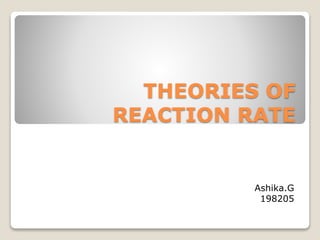
Theories of Reaction Rate - Ashika G
- 2. Reaction rate The rate of the reaction is defined as the change in concentration of any reactant or product per unit time. Rate of the Reaction = Rate of disappearance of A = Rate of appearance of B Rate = -d[A]/-dt = d[B]/dt Theories of reaction rate : 1) Collision theory 2) Transition state theory
- 3. Collision Theory : According to this theory, The molecules of reactants are assumed to be hard spheres and reactions are assumed to occur only when these hard spheres(molecules) collide with each other. Not all collisions are effective Only a small fractions of the collisions produce a reaction. Two conditions 1) Kinetic energy of the colliding molecules 2) Orientation factor Kinetic energy of the colliding molecules: The molecules must collide with sufficient kinetic energy A-A + B-B → 2A-B
- 4. Chemical reaction occurs by breaking the bonds between the atoms of reacting molecules and forming the new bonds in the product molecules. The energy comes from the kinetic energy possessed by the reacting molecules before the collision. Energy barrier Ea A-A B-B Energy Reactant 2A-B Product Reaction coordinate
- 5. Ea = activation energy Activation energy is the minimum energy necessary to cause the collision between the reacting molecules. Molecules with kinetic energy greater than the Ea are able to get over the energy barrier and react Effective collision Molecules colliding with Kinetic energy less than Ea fail to get over the barrier the collision between them are unproductive and the molecules simply bounce off one another Ineffective collision
- 6. Orientation factor: The molecules must collide with correct orientation. Only the molecules with kinetic energy greater than Ea and with correct orientation can cause reaction. The correct orientation is that which ensure direct contact between the atoms involved in the breaking and forming of bonds. Example: H2 + I2 → 2HI
- 7. + Molecular approach Bond formation + + Molecular approach Bond separation + H H I I H H I I I H I H HH I I H H II HH II
- 8. Rate of the reaction = Collision frequency ∙ energy factor ∙ Orientation factor Collision frequency is the total number of collision per unit time per unit volume. Energy factor is the fraction of collision that have sufficient energy ( ≥Ea ) Orientation factor is the fraction of collision having proper orientation . Rate of the reaction = Z ∙ e-Ea/RT ∙ P Z =2n2σ2 √ᴨkbT/m n = number of molecules per unit volume m = mass of the molecules kb = Boltzman constant T = temperature σ = Diameter of colliding molecules ( A and B )
- 9. Drawbacks of collision theory: The theory is only applicable to simple gas where the reacting molecules are simple molecules. The expression from collision theory only applies to simple bimolecular reactions. In this theory only kinetic energy of the reacting molecules are considered, while the rotational and vibrational energies are ignored. It considers all the atoms to be hard spheres and ignores their structures.
- 10. AB# Transition state Ea Energy A+B Reactant C Product Reaction coordinate Transition state theory According to this theory, the reactant molecules is first transformed into intermediate transition state. The transition state is formed by loose association or bonding of reactant molecules. The activated complex is unstable and breaks into the products at a definite rate.
- 11. The theory suggests that there are three major factors that determine whether a reaction will occur : The concentration of the activated complex. The rate at which the activated complex breaks apart. whether it breaks apart to reform the reactants or whether it breaks apart to form a new complex, the products. Consider a reaction A+B →C The rate law is given by, Rate = k[A][B] (1) Where k is rate constant. According to activated state model Transition state AB# is formed K# k # A+B [AB]# C Rate =k#[AB]# k# is the rate constant of activated complex
- 12. K# = [AB]#/[A][B] Rate of the reaction depends on the two factors 1)concentration activated complex and 2) Frequency of vibration of activated complex that converts activated complex to products. Hence Rate= ν[AB#] Rate= ν[A][B]K# where, ν = kbT/h Kb = Boltzman constant h = planck’s constant Therefore , Rate = K#[A][B]∙kbT/h (2)
- 13. Comparing equation (1) and (2) k[A][B]= K#[A][B]∙kbT/h k = kbT/h∙K#
- 14. Difference between transition state theory and collision theory : Collision theory Transition state theory Describes the collision of gas molecules in gas phase with sufficient kinetic energy. Explains reaction rates by assuming the formation of intermediate compound that are transition state States chemical reaction occur due to collision between reactants States that chemical reaction occur by going through transition state. The collision theory used to predict the rates of chemical reactions particularly for gases TST can be used to determine the reaction rates of elementary reactions.
- 15. References : Chemical Kinetics and Reaction dynamics – Santhosh K. Upadhyay Chemical kinetics - Keith J. Laidler https://chem.libretexts.org.
Editor's Notes
- Reaction rate
